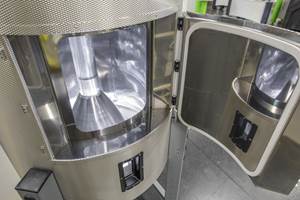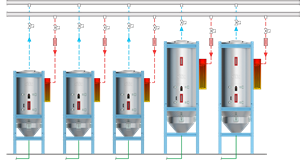AUXILIARY EQUIPMENT: New Controls for Conveying, Mobile Drying
New dense-phase conveying system among the new products Conair to display at K.
Conair's dense-phase vacuum-conveying system—R-PRO—which debuted at NPE2015 (read more here), will make its European debut at the K show, along with a new conveying control, a mobile drying/conveying unit, and several products from the company’s MedLine series of cleanroom-ready auxiliaries.
New to the market will be the FLX-128 Plus conveying control, which now can be set up to operate the R-PRO system, as well as some of Conair’s newer conveying products, including its line-proofing systems. At K, the FLX-128 Plus will in fact control an R-PRO conveying system. Using a combination of centralized I/O and expansion modules, which are interconnected via industrial Ethernet to provide control of up to 128 receivers, 40 pumps (plus 2 back-up pumps) and 256 source valves, Conair says the FLX-128 Plus has all the features of the previous web-enabled FLX-128, but is now “smarter, faster, and more powerful.” As mentioned, it also integrates Conair’s newest line-proofing system: Invisible Line Proofing (ILP). A full color touch screen featuring graphical icons is said to ensure intuitive monitoring and operation of up to 40 independently operating vacuum systems.
For the first time anywhere, Conair will display a mobile drying/conveying system (MDCW) featuring its newest DC-A touchscreen control interface, at the K. Combining a Carousel Plus Dryer with a conveying blower, dust collector and direct-feed vacuum receiver, the MDCW allows processors to convey dried material directly to a machine. Integrated onto a mobile cart, the system features a DC鈥慉 touchscreen control that reportedly has an intuitive graphical design, minimal text, and no function codes to decipher.
In addition to help screens and features auto-start capabilities, the MDCW control has password protection and Conair’s drying monitor capabilities built in. In addition, trending capabilities can help simplify maintenance and troubleshooting, as well as drying process optimization. The new DC-A control will also be offered on smaller Conair desiccant-wheel dryers.
On display from Conair’s MedLine range of auxiliaries, which features 40 different clean-room ready models and 170 different configurations, a MedLine MicroWheel dryer with a MedLine TubeLoader. The MicroWheel, with its downsized capacity, is offered as an alternative to larger systems for processors running small quantities of engineering resins. At the show, the dryer will be fitted with the compact, self-contained MedLine TubeLoader, featuring a built-in vacuum motor capable of conveying 150 lb/hr (68 kg/hr) nearly 20 ft (6 m). Also shown in the MedLine configuration will be a TB-45 TrueBlend gravimetric blender mounted on a floor stand and equipped with two Access vacuum receivers.
The patent-pending R-PRO technology, which uses dense-phase vacuum-conveying to minimize pellet fracturing, moves materials at speeds range from as slow as 70 m/min (230 ft/min) up to 366 m/min (1200 ft/min). Conair notes that it can be retrofitted to existing systems.
Other Conair products exhibited at K 2016 will include its patent-pending Invisible Line Proofing (ILP) system, which uses a proprietary non-electrical sensing technology to confirm that the proper resin source is connected to the selected destination; and a new dual-spindle automatic cut-and-transfer coiler (ATC), designed for high-speed winding of small-diameter extruded tubing and flexible profiles. Conair says that even at high speeds, little or no friction or tension is generated, preventing deformities. Winding transfers to new reels are fully automated. Finally, Conair’s stand will feature its NCF-814 granulator, which has tangential cutting chamber capable of converting containers and other bulky scrap into clean, uniform regrind.
Related Content
Service Enables One-Day Auxiliary Commissioning
One-day, on-site equipment setup and training assistance program for all types of Conair auxiliaries.
Read MoreNovel Hopper Design for More Efficient Resin Drying
Patented internal geometry and unique thermodynamic properties significantly enhance the drying process, offering a 33% reduction in drying time compared to traditional systems.
Read MoreResin Drying Hoppers Offer More Energy Efficiency, Durability and Cleanability
NPE2024: Drying hoppers provide improved energy efficiency and a durable textured metal exterior finish. Thicker insulation provides a cooler working environment, while polished stainless steel interiors resist material entrapment, and make cleanouts and changeovers faster.
Read MoreHow to Effectively Reduce Costs with Smart Auxiliaries Technology
As drying, blending and conveying technologies grow more sophisticated, they offer processors great opportunities to reduce cost through better energy efficiency, smaller equipment footprints, reduced scrap and quicker changeovers. Increased throughput and better utilization of primary processing equipment and manpower are the results.
Read MoreRead Next
People 4.0 – How to Get Buy-In from Your Staff for Industry 4.0 Systems
Implementing a production monitoring system as the foundation of a ‘smart factory’ is about integrating people with new technology as much as it is about integrating machines and computers. Here are tips from a company that has gone through the process.
Read MoreFor PLASTICS' CEO Seaholm, NPE to Shine Light on Sustainability Successes
With advocacy, communication and sustainability as three main pillars, Seaholm leads a trade association to NPE that ‘is more active today than we have ever been.’
Read More









